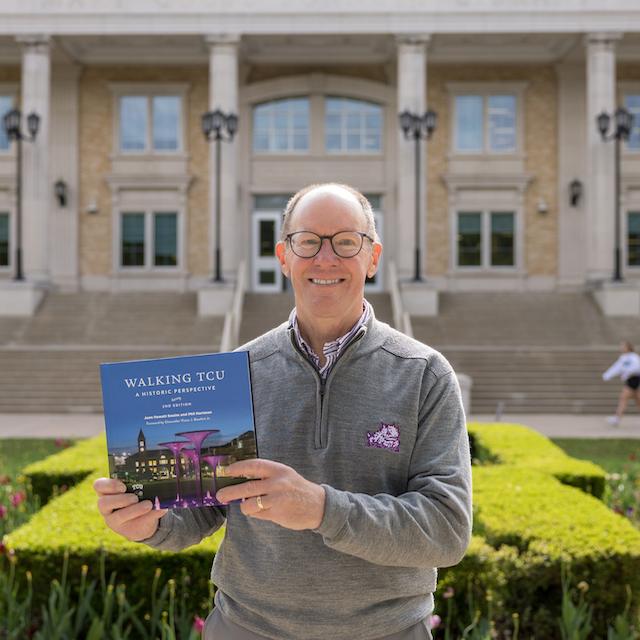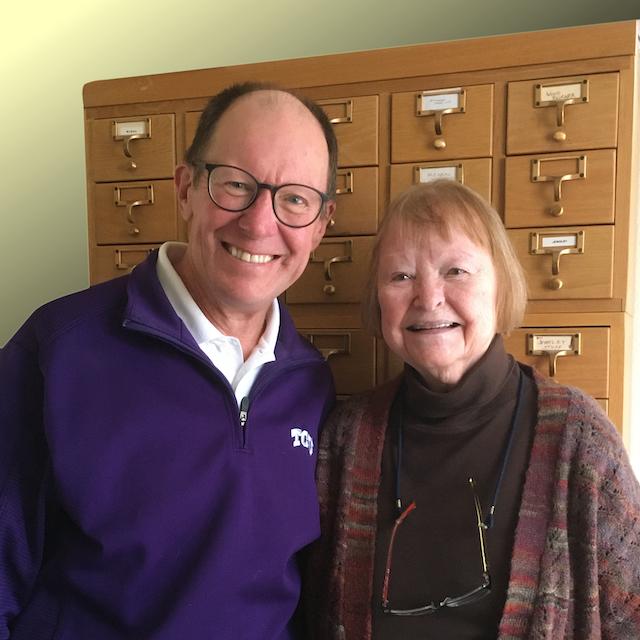
‘A Very Different Walk’: Walking TCU Celebrates TCU’s 150th
With campus in its prettiest of palettes, spring is the ideal time to take a walk around TCU. Phil Hartman can be your guide, thanks to the recent publication of Walking TCU: A Historic Perspective, the second edition, in honor of TCU’s Sesquicentennial.

The original Walking TCU by Joan Hewatt Swaim, former TCU reference librarian with family ties to the university, was published in 1992 and gives an account of the university’s history and the people who shaped it. The book’s focus was on the buildings and other campus structures – and one of Hartman’s favorites.
“About 10 years ago I thought it would be good to update the book, given how many new structures had been built since it was first published,” said the emeritus dean and professor in the TCU College of Science & Engineering. “Walking TCU today is a very different walk.”
Writing a book was a first for Hartman, but a great work-retirement transition. He served as dean of the College of Science & Engineering from 2012 until his 2021 retirement.
“TCU has stunning grounds and is gorgeous,” Hartman said, noting its pedestrian friendly walkways, the sculptures, memorials and green space that abound. “I’m not a trained historian or architect, but I spent more than 40 years on this campus and love it and the people.”
As a fan of campus architecture, Hartman calls the university’s physical transformation in the past 20-plus years its Golden Era, crediting much of that to Chancellor Victor J. Boschini, Jr.
“The campus has been physically transformed during his tenure as chancellor, a transformation that includes not only substantive upgrades to literally every building on campus but also the construction of 57 new buildings, including 20 residence halls (counting Worth Hills Village),” Hartman writes.
To bring Walking TCU up to date, Hartman reconnected with Swaim, who offered suggestions as he added post-1992 descriptions for existing buildings that have been renovated. He spent hours in the library combing through past issues of the Skiff and TCU Magazine as well as interviewing numerous TCU staff who provided their expertise and feedback.
Hartman’s version adds two chapters on TCU’s early days, first in Thorp Spring, and then Waco, plus a “Frog Bites” section of interesting factoids, like the number of bricks that went into the 2010 makeover of Amon G. Carter Stadium (791,520).
Then, with colorful maps illustrating various quadrants of the campus, Hartman’s tour starts at the Dee J. Kelly Alumni & Visitors Center and the Campus Commons, providing an overview of what visitors will see in the buildings and how they were integrated into surrounding environs.
Donors who made the buildings possible are recognized, as are trustees and other TCU leaders whose portraits grace hallways. Their histories as well as history of the property are noted. For example, the Campus Commons space is situated on land that, before it was a student union, operated a dairy that supplied milk to the school’s boarding facility. (It ceased operating before 1930.)
Next, the tour takes readers to what was the original Fort Worth campus and some of its oldest buildings. From here, the south side of the west campus is explored, followed by a look at the TCU buildings along Berry Street and University Drive, with a nod to nearby shops and restaurants that have come and gone.
Crossing University Drive to East Campus, the next chapter is the book’s longest, given this portion of campus has more academic buildings, the Mary Couts Burnett Library and Robert Carr Chapel. The remaining chapters cover the north side of West Campus, athletic complexes, Worth Hills and a collection of what Hartman labeled “miscellany.”
Throughout the book are black and white and color photos culled from the library archives as well as Marketing & Communication’s digital files.
“It was not an insignificant feat to parse through those,” Hartman said, noting that when photos weren’t available, several local photographers filled the gap.
In the foreward of Walking TCU, Boschini notes: “TCU has come so far. Never could the founders and early TCU leaders predict the expansive campus of today. As we salute the past and toast the future, I hope we will all acknowledge the people and recount the many bold steps taken to reach this remarkable high point in TCU’s history. I also salute those scholars who contributed to this excellent updated version of Walking TCU.”
The hardback is available through TCU Press and in limited quantities at the TCU Campus Store.
Learn about other 150th commemorative books including Images and Stories of TCU's First 100 Years 1873-1973, A History to Remember: TCU in Purple, White, and Black, A Remarkable Story to Tell and A Hope of Wisdom.
